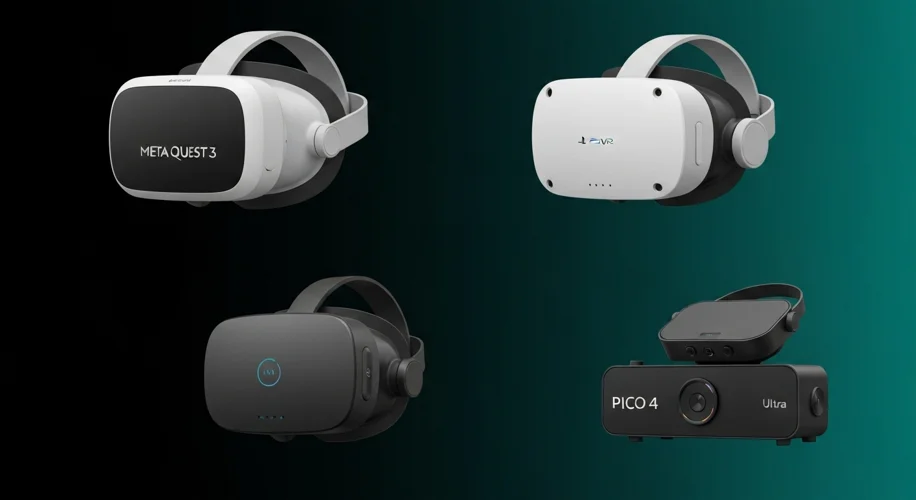Alright, let’s talk VR. If you’re anything like me, you’ve probably been eyeing the virtual world for a while now, wondering which headset is actually worth your hard-earned cash. As of August 2025, the market is buzzing, and picking the right one can feel like navigating a maze. So, let’s break down the heavy hitters and figure out where you should put your virtual dollars.
Meta Quest 3 vs. Quest 3S: The Family Feud
First up, the Meta lineup. The Quest 3 is still a solid contender, offering a great all-around experience with mixed reality capabilities thanks to its color passthrough. It’s fantastic for gaming, social VR, and even some productivity if you’re feeling adventurous. It connects wirelessly via Wi-Fi or directly to your PC with a USB-C cable.
Then there’s the newer Quest 3S. Think of this as the streamlined, more budget-friendly option. It might trim a few bells and whistles, perhaps focusing more on pure VR gaming and less on the advanced mixed reality features of its bigger sibling. It’s likely to offer a very similar core experience but at a lower entry price, making VR more accessible. For most people looking to jump into standalone VR or decent PC VR without breaking the bank, the Quest 3S is probably going to be the sweet spot.
Beyond Meta: Other Players in the Arena
But it’s not all Meta. We’ve got some serious competition:
- PlayStation VR2 (PSVR2): If you’re a PlayStation owner, this is your go-to. It offers stunning visuals and excellent haptic feedback, really immersing you in games. The main limitation? It’s tied to the PlayStation ecosystem, so you won’t be connecting this to your PC.
- Pico 4 Ultra: Pico has been steadily improving, and the Ultra aims to compete directly with the Quest line, often offering a slightly different feature set or price point. It’s known for its comfortable design and good display quality, often providing a solid standalone VR experience and PC VR connectivity.
- Bigscreen Beyond 2: This is for the true enthusiasts. Bigscreen focuses on ultra-lightweight, custom-fit headsets for maximum comfort during long sessions. Expect top-tier visuals but be prepared for a higher price tag and, crucially, you’ll need a powerful PC to drive it. It’s all about PC VR here.
So, Which One is For You?
- Budget-Conscious Explorer: The Quest 3S is likely your best bet. It offers a great entry into standalone VR and decent PC VR without costing an arm and a leg.
- All-Around Enthusiast: The Quest 3 still holds its own. If you want robust mixed reality and a proven ecosystem, it’s a fantastic choice.
- PlayStation Power User: Stick with the PSVR2. It’s the most seamless way to get high-quality VR on your console.
- The PC VR Purist: If you have a beast of a PC and prioritize comfort and visual fidelity above all else, the Bigscreen Beyond 2 is worth investigating, though it’s a premium investment.
PC Requirements & Connection:
This is HUGE, especially if you’re eyeing PC VR.
- Quest 3/3S: Can run standalone, but for PC VR (using Oculus Link or Virtual Desktop), you’ll need a VR-ready PC. Think at least an NVIDIA RTX 3060 or AMD RX 6700 XT, paired with a decent CPU (like an Intel Core i5 or AMD Ryzen 5 from recent generations) and 16GB of RAM. Wireless is amazing, but a wired connection offers the most stability.
- PSVR2: No PC needed, just a PS5. Plug and play.
- Pico 4 Ultra: Similar PC requirements to the Quest 3 for PC VR. Wireless and wired options are available.
- Bigscreen Beyond 2: Demands the highest specs. You’ll want an RTX 4070 or higher, a powerful CPU, and ample RAM for the best experience.
Ultimately, the ‘perfect’ VR headset is the one that fits your needs, your wallet, and your existing tech setup. Do your research based on what you want to do in VR, and you’ll land in the right reality. Happy questing!

